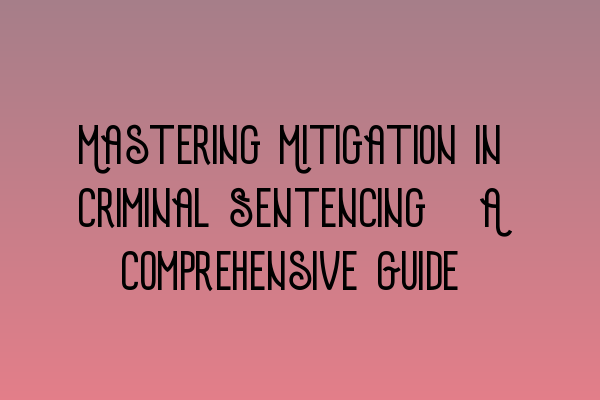Mastering Mitigation in Criminal Sentencing: A Comprehensive Guide
As solicitors and legal professionals at SQE Criminal Law & Practice Law UK, we understand the importance of effectively presenting mitigating factors during criminal sentencing. Mitigation plays a crucial role in influencing the court’s decision, and mastering this skill is essential for successful advocacy.
Understanding Mitigation
Mitigation refers to presenting evidence, circumstances, or arguments to the court that aim to reduce the severity of a defendant’s sentence. It allows defendants to explain any factors that may have contributed to their actions and demonstrate remorse or rehabilitation.
When it comes to sentencing, judges consider various factors, including the nature and seriousness of the offense, the defendant’s criminal history, the impact on victims, and any aggravating or mitigating circumstances. Mitigation addresses the latter by highlighting factors that may justify a more lenient sentence.
Effective Mitigation Strategies
Mastering mitigation requires careful preparation and thoughtful execution. Here are some effective strategies that can help maximize the impact of your client’s mitigation:
- Gathering and Presenting Evidence: Collect comprehensive evidence that supports your client’s mitigating factors. This can include character references, testimonials, medical reports, or evidence of rehabilitation. Present it in a concise and organized manner to strengthen your argument.
- Contextualizing the Offense: Provide the court with a thorough understanding of the circumstances surrounding the offense. Explain any contextual factors that may have influenced your client’s behavior, such as financial hardship, mental health issues, or coercion.
- Showcasing Remorse and Rehabilitation: Demonstrate that your client has taken positive steps toward rehabilitation by highlighting any relevant programs, counseling, or community service they have engaged in. Emphasize their genuine remorse and commitment to change.
- Emphasizing Personal Circumstances: Shed light on any personal circumstances that may have contributed to the offense, such as a difficult upbringing, trauma, or addiction. This helps the court understand the underlying factors and consider leniency.
Key Elements of Effective Mitigation Submission
When presenting mitigation, it is crucial to structure your submission effectively. Here are some key elements to include:
- Introduction: Begin with a concise but impactful introduction, summarizing your client’s situation and providing a brief outline of the mitigating factors you will be presenting.
- Mitigating Factors: Present the mitigating factors one by one, providing relevant evidence and explanations for each. Clearly articulate how these factors should be taken into consideration when determining the sentence.
- Impact Statement: If applicable, include an impact statement from the victim or affected party, emphasizing any restorative justice or reconciliation efforts made.
- Conclusion: Conclude your submission by summarizing the key points and reiterating the importance of the mitigating factors in achieving a fair and just sentence.
Mastering mitigation requires practice, attention to detail, and an understanding of the specific judicial practices and precedents. At SQE Criminal Law & Practice Law UK, we offer comprehensive SQE 1 and SQE 2 preparation courses to help aspiring solicitors develop the necessary skills to excel in criminal law.
